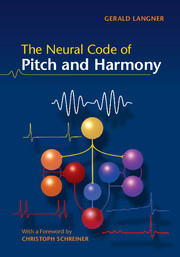Book contents
- Frontmatter
- Contents
- Preface
- Foreword
- 1 Historical aspects of harmony
- 2 Sound and periodicity
- 3 The discovery of the missing fundamental
- 4 The pitch puzzle
- 5 The auditory time constant
- 6 Pathways of hearing
- 7 Periodicity coding in the brainstem
- 8 Periodicity coding in the midbrain
- 9 Theories of periodicity coding
- 10 Periodotopy
- 11 The neural code of harmony
- 12 The oscillating brain
- References
- Index
7 - Periodicity coding in the brainstem
Published online by Cambridge University Press: 05 May 2015
- Frontmatter
- Contents
- Preface
- Foreword
- 1 Historical aspects of harmony
- 2 Sound and periodicity
- 3 The discovery of the missing fundamental
- 4 The pitch puzzle
- 5 The auditory time constant
- 6 Pathways of hearing
- 7 Periodicity coding in the brainstem
- 8 Periodicity coding in the midbrain
- 9 Theories of periodicity coding
- 10 Periodotopy
- 11 The neural code of harmony
- 12 The oscillating brain
- References
- Index
Summary
Periodicity coding in the auditory nerve
Temporal coding
As we know from the previous chapter, a pure tone activates a certain place on the basilar membrane maximally, and hair cells at this place code the frequency of that signal by their position along the membrane. However, we also know that this labelled line coding, or ‘place information’, alone is not sufficient to explain the acuity of our perception and that the central auditory system obviously must make use of additional information that is supplied by the temporal firing patterns of the nerve fibres.
We also saw that the limited frequency resolution of our cochlea is actually advantageous for the temporal analysis of – for example – a harmonic sound. When its frequency range is sufficiently broad, neural responses in many frequency channels will be elicited by a waveform that is a superposition of harmonic components of the harmonic sound. As a consequence, hair cells signal the presence and intensity of the harmonics to which they are tuned to the central auditory system, but they also transmit temporal information about this superposition. Because all the components of a harmonic sound are integer multiples of its fundamental frequency, the periodicity of their superposition will correspond to that of the fundamental frequency (or a multiple thereof, if certain harmonics are missing). As a result, the fundamental of a harmonic sound is encoded by the temporal discharge patterns of auditory nerve fibres even if it is physically absent. This explains why, after a corresponding temporal analysis in the central auditory system, we are able to perceive the pitch of what Schouten called the ‘missing fundamental’.
If the fundamental can be coded in the auditory nerve, the question arises as to how the corresponding temporal information is decoded in the nervous system and how the properties of the nerve and the neurons in the brain contribute to this temporal analysis.
- Type
- Chapter
- Information
- The Neural Code of Pitch and Harmony , pp. 88 - 104Publisher: Cambridge University PressPrint publication year: 2015



